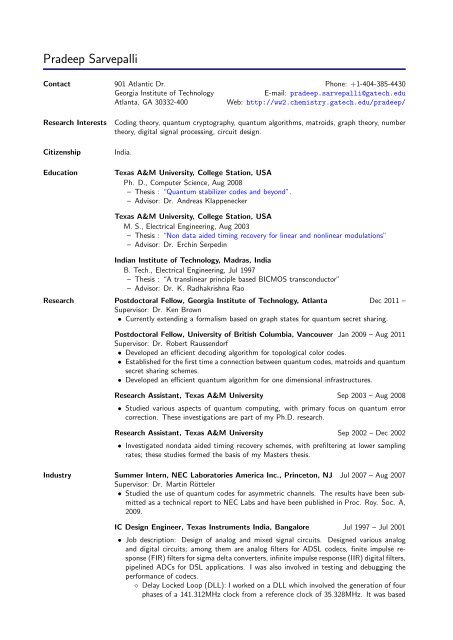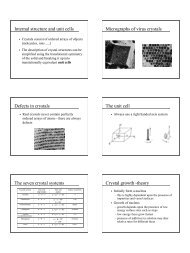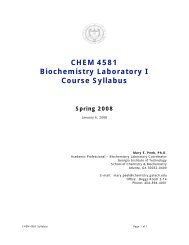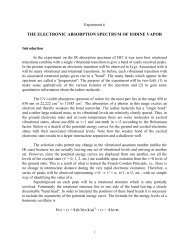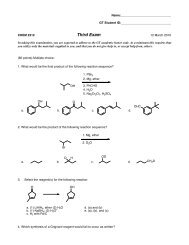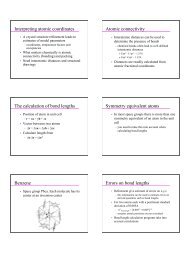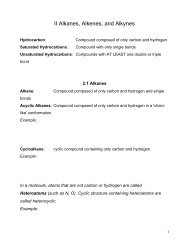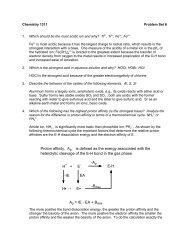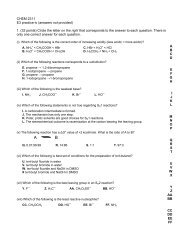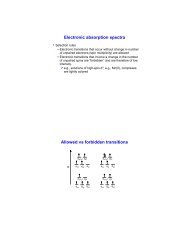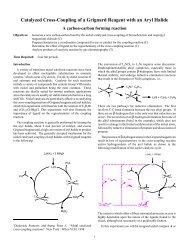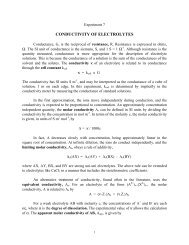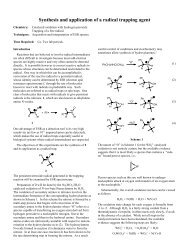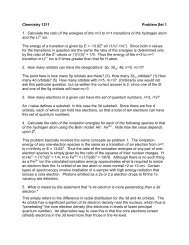CV - Georgia Institute of Technology
CV - Georgia Institute of Technology
CV - Georgia Institute of Technology
- No tags were found...
Create successful ePaper yourself
Turn your PDF publications into a flip-book with our unique Google optimized e-Paper software.
Pradeep SarvepalliContact 901 Atlantic Dr. Phone: +1-404-385-4430<strong>Georgia</strong> <strong>Institute</strong> <strong>of</strong> <strong>Technology</strong>E-mail: pradeep.sarvepalli@gatech.eduAtlanta, GA 30332-400Web: http://ww2.chemistry.gatech.edu/pradeep/Research InterestsCitizenshipEducationCoding theory, quantum cryptography, quantum algorithms, matroids, graph theory, numbertheory, digital signal processing, circuit design.India.Texas A&M University, College Station, USAPh. D., Computer Science, Aug 2008– Thesis : “Quantum stabilizer codes and beyond”.– Advisor: Dr. Andreas KlappeneckerTexas A&M University, College Station, USAM. S., Electrical Engineering, Aug 2003– Thesis : “Non data aided timing recovery for linear and nonlinear modulations”– Advisor: Dr. Erchin SerpedinIndian <strong>Institute</strong> <strong>of</strong> <strong>Technology</strong>, Madras, IndiaB. Tech., Electrical Engineering, Jul 1997– Thesis : “A translinear principle based BICMOS transconductor”– Advisor: Dr. K. Radhakrishna RaoResearch Postdoctoral Fellow, <strong>Georgia</strong> <strong>Institute</strong> <strong>of</strong> <strong>Technology</strong>, Atlanta Dec 2011 –Supervisor: Dr. Ken Brown• Currently extending a formalism based on graph states for quantum secret sharing.Postdoctoral Fellow, University <strong>of</strong> British Columbia, Vancouver Jan 2009 – Aug 2011Supervisor: Dr. Robert Raussendorf• Developed an efficient decoding algorithm for topological color codes.• Established for the first time a connection between quantum codes, matroids and quantumsecret sharing schemes.• Developed an efficient quantum algorithm for one dimensional infrastructures.Research Assistant, Texas A&M University Sep 2003 – Aug 2008• Studied various aspects <strong>of</strong> quantum computing, with primary focus on quantum errorcorrection. These investigations are part <strong>of</strong> my Ph.D. research.Research Assistant, Texas A&M University Sep 2002 – Dec 2002• Investigated nondata aided timing recovery schemes, with prefiltering at lower samplingrates; these studies formed the basis <strong>of</strong> my Masters thesis.Industry Summer Intern, NEC Laboratories America Inc., Princeton, NJ Jul 2007 – Aug 2007Supervisor: Dr. Martin Rötteler• Studied the use <strong>of</strong> quantum codes for asymmetric channels. The results have been submittedas a technical report to NEC Labs and have been published in Proc. Roy. Soc. A,2009.IC Design Engineer, Texas Instruments India, Bangalore Jul 1997 – Jul 2001• Job description: Design <strong>of</strong> analog and mixed signal circuits. Designed various analogand digital circuits; among them are analog filters for ADSL codecs, finite impulse response(FIR) filters for sigma delta converters, infinite impulse response (IIR) digital filters,pipelined ADCs for DSL applications. I was also involved in testing and debugging theperformance <strong>of</strong> codecs.⋄ Delay Locked Loop (DLL): I worked on a DLL which involved the generation <strong>of</strong> fourphases <strong>of</strong> a 141.312MHz clock from a reference clock <strong>of</strong> 35.328MHz. It was based
on a DLL that was designed to work as a clock multiplier. The design also involvedclose working with the systems engineer in generating the specifications for the blockand developing the overall timing recovery.⋄ Programmable IIR filters: The filters were designed as a cascade <strong>of</strong> two second orderbiquadratic filters with programmable coefficients. The design involved optimizationfor filter coefficients and data widths, limit cycle presence, overflow detection.⋄ Decimation filters for sigma delta ADCs: It involved the design <strong>of</strong> programmablesinc, halfband filters. It also involved the design <strong>of</strong> a multi-band FIR filter foroptimal performance. The design took into account the effect <strong>of</strong> data and coefficientquantization, overflow detection and area optimization.⋄ Pipelined ADCs: I worked on a dual channel 14 bit 4.416MHz pipelined ADC forDSL applications. It incorporated statistical design to avoid over design. It involvedspecial design considerations for reducing the crosstalk between the two channelsthrough the capacitor hystersis. I have also worked on the design <strong>of</strong> a 13.332 MHz13-bit pipelined ADC for an Etherloop Codec.⋄ Analog Filters: I designed a 5th order high pass filter which was a cascade <strong>of</strong> 2ndorder Chebyshev and 3rd order elliptic filter. The design also involved trimming thefilter for process variation and sensitivity analysis.⋄ Testing: I have also been involved in testing <strong>of</strong> codecs used in DSL modems. In specificthe work involved characterizing and debugging the performance <strong>of</strong> the ADCs,DACs, voltage references, PGAs, analog and digital filters which are commonly part<strong>of</strong> codecs.Teaching Teaching Assistant, ECE Department, Texas A&M University Jan 2003 – May 2003• TA for an undergraduate course on Electric Circuits. The job responsibilities includedteaching for the labs, setting exams involving theory and experiments.PublicationsJournal (12)27. P. Sarvepalli and R. Raussendorf. Efficient Decoding <strong>of</strong> Topological Color Codes. AcceptedPhys. Rev. A.26. P. Sarvepalli. Entropic inequalities for a class <strong>of</strong> quantum secret sharing schemes. Phys.Rev. A. 83, 042303, 2011.25. P. Sarvepalli. Bounds on the information rate <strong>of</strong> quantum secret sharing schemes.Phys. Rev. A. 83, 042324, 2011.24. P. Sarvepalli and R. Raussendorf. Local equivalence, surface code states and matroids.Phys. Rev. A 82, 022304, 2010.23. P. Sarvepalli and R. Raussendorf. Matroids and quantum secret sharing schemes. Phys.Rev. A 81, 052333, 2010.22. P. K. Sarvepalli and A. Klappenecker. Degenerate quantum codes and the quantumHamming bound. Phys. Rev. A 81, 032318, 2010.21. P.K. Sarvepalli and A. Klappenecker. Encoding subsystem codes International Journalon Advances in Security, vol 2, no. 2 and 3, pages 142-155, 2009.20. P. K. Sarvepalli and A. Klappenecker. Sharing classical secrets with Calderbank-Shor-Steane codes. Phys. Rev. A 80, 022321, 2009.19. P. K. Sarvepalli, A. Klappenecker, and M. Rötteler. Asymmetric Quantum Codes:Constructions, Bounds, and Performance. Proc. Roy. Soc. A, May 2009 vol. 465 no.2105 1645-167218. A. Klappenecker and P. K. Sarvepalli. Clifford code constructions <strong>of</strong> operator quantumerror correcting codes. IEEE Trans. Inform. Theory, 54(12):5760–5765, 2008.17. A. Klappenecker and P. K. Sarvepalli. On subsystem codes beating the quantumHamming or Singleton bound. Proc. Roy. Soc. A, 463, 2887–2905, 2007.16. S. A. Aly, A. Klappenecker, and P. K. Sarvepalli. On quantum and classical BCHcodes. IEEE Trans. Inform. Theory, 53(3):1183–1188, 2007.
15. A. Ketkar, A. Klappenecker, S. Kumar, and P. K. Sarvepalli. Nonbinary stabilizer codesover finite fields. IEEE Trans. Inform. Theory, 52(11):4892–4914, 2006.Conference (14)Book Chapters14. P. Sarvepalli, and R. Raussendorf. Local equivalence <strong>of</strong> surface code states. 16 pages,In Proceedings <strong>of</strong> The 5th Conference on the Theory <strong>of</strong> Quantum Computation, Communicationand Cryptography, 2010. Apr 13-15, University <strong>of</strong> Leeds, UK.13. P. Sarvepalli. Topological color codes over higher alphabet. (Invited) IEEE Informationtheory workshop 2010, Dublin, Ireland.12. P. K. Sarvepalli, M. Rötteler, and A. Klappenecker. Decoding Algorithm for a GenaralizedShor Codes and A class <strong>of</strong> Subsystem Codes. Proc. Intl. Symposium onInformation Theory, Toronto, Canada, 2009.11. P. K. Sarvepalli and A. Klappenecker. Encoding subsystem codes with and withoutnoisy gauge qubits. (Best Paper Award) In Proc. ICQNM 2009, The Third InternationalConference on Quantum, Nano and Micro Technologies, February 1-6, 2009Cancun, Mexico.10. P. K. Sarvepalli, M. Rötteler, and A. Klappenecker. Asymmetric quantum LDPC codes.Proc. Intl. Symposium on Information Theory, Toronto, Canada, 2008.9. S. A. Aly, A. Klappenecker, and P. K. Sarvepalli. Duadic group algebra codes. In Intl.Symposium on Information Theory, Nice, France, 2007.8. S. A. Aly, A. Klappenecker, and P. K. Sarvepalli. Quantum convolutional codes fromgeneralized Reed-Solomon codes. In Intl. Symposium on Information Theory, Nice,France, 2007.7. S. A. Aly, M. Grassl, A. Klappenecker, M. Roetteler, and P. K. Sarvepalli. Quantumconvolutional BCH codes In Proc. 10th Canadian Workshop on Information Theory,Edmonton, Canada, 2007.6. S. A. Aly, A. Klappenecker, and P. K. Sarvepalli. Subsystem codes. (Invited) InForty-Fourth Annual Allerton Conference on Communication, Control, and Computing,Illinois, USA, 2006.5. S. A. Aly, A. Klappenecker, and P. K. Sarvepalli. Primitive BCH codes over finitefields. In Intl. Symposium on Information Theory, Seattle, USA, 2006.4. S. A. Aly, A. Klappenecker, and P. K. Sarvepalli. Remarkable degenerate quantumstabilizer codes derived from duadic codes. In Intl. Symposium on Information Theory,Seattle, USA, 2006.3. P. K. Sarvepalli and A. Klappenecker. Nonbinary quantum codes from hermitiancurves. In M. Fossorier et al., (eds), Applied Algebra, Algebraic Algorithms and Error-Correcting Codes: 16th International Symposium, AAECC-16, Las Vegas, NV, USA,February 20-24, 2006.2. A. Klappenecker and P. K. Sarvepalli. Nonbinary quantum Reed-Muller codes. InProc. 2005 IEEE Intl. Symposium on Information Theory, Adelaide, Australia, pages1023-1027, 2005.1. Pradeep Kiran and K. Radhakrishna Rao. A novel BIMOS translinear principle basedtransconductor. IEEE International Conference on VLSI, Madras, India, 1998.1. P. K. Sarvepalli, S. A. Aly, and A. Klappenecker. Nonbinary stabilizer codes. In (eds)G. Chen, L. Kauffman and S. Lomonaco, Jr., Mathematics <strong>of</strong> quantum computationand quantum technology, Taylor and Francis, 2007.
PreprintsPresentations5. R. Raussendorf, P. Sarvepalli, T.-C. Wei, and P. Haghnegahdar. Measurement-basedquantum computation–a quantum-mechanical toy model for spacetime?, arXiv:1108.5774,2011.4. P. Sarvepalli and P. Wocjan. Quantum algorithms for one-dimensional infrastructures,arXiv:1106.6347, 2011.3. P. Sarvepalli. Quantum codes and symplectic matroids, arXiv:1104.1171, 2011.2. A. Klappenecker and P. K. Sarvepalli. Encoding subsystem codes. arXiv:0806.4954,2008.1. P. Sarvepalli and A. Klappenecker. Asymptotics <strong>of</strong> the quantum Hamming bound forsubsystem codes. arXiv:0710.4271, 2007.— Quantum codes and symplectic matroids. (Invited) The 3rd biennial Canadian Discreteand Algorithmic Mathematics Conference (CanaDAM), May 31-June 3, 2011,University<strong>of</strong> Victoria in Victoria, BC, Canada.— Quantum codes, symplectic matroids and secret sharing schemes. Seminar on quantumtopology and quantum computing, Ohio State University, Columbus, USA, May 25,2011.— Matroids in quantum information processing. Université <strong>of</strong> Sherbrooke, Canada, April12, 2011.— Topological color codes over prime power alphabet. Discrete Math Seminar, SimonFraser University, Vancouver, Canada, Dec 7, 2010.— Quantum secret sharing schemes: Constructions and bounds. Centre for QuantumTechnologies, National University <strong>of</strong> Singapore, Singapore, Nov 11, 2010.— Topological color codes over higher alphabet. (Invited) IEEE Information TheoryWorkshop, Dublin, Ireland, Aug 30–Sep 3, 2010.— Local equivalence <strong>of</strong> surface code states. Theory <strong>of</strong> Quantum Computation, Communicationand Cryptography, University <strong>of</strong> Leeds, UK, April 13–15 2010.— Quantum secret sharing, Matroids and stabilizer codes. (Invited) Canadian MathematicalSociety Summer Meeting, New Brunswick, 2010.— Matroids in quantum computing and quantum cryptography. (Invited) Applications <strong>of</strong>Matroid Theory and Combinatroial Optimization to Coding Theory, Banff InternationalResearch Station, Banff, Aug 2–7, 2009.— Quantum secret sharing with CSS codes. Quantum Information Seminar, Department<strong>of</strong> Physics and Astronomy, University <strong>of</strong> British Columbia, Vancouver, Apr 29, 2009— Sharing classical secrets with CSS codes. Center for Advanced Studies Seminars,University <strong>of</strong> New Mexico, Albuquerque, Nov 6, 2008.— Asymmetric quantum LDPC codes. In IEEE Intl. Symposium on Information Theory,Toronto, Canada, Jul 6–11, 2008.— Two approaches to sparse graph quantum codes. Quantum information and graphtheory: Emerging connections, Perimeter <strong>Institute</strong> for Theoretical Physics, Waterloo,Apr 28 – May 2, 2008.— Remarkable degenerate quantum stabilizer codes derived from duadic codes. In IEEEIntl. Symposium on Information Theory, Seattle, USA, 2006.— Nonbinary quantum codes from Hermitian curves. In Applied Algebra, Algebraic Algorithmsand Error-Correcting Codes: 16th Intl. Symposium, AAECC-16, Las Vegas,NV, USA, February 20–24, 2006.— Nonbinary quantum Reed-Muller codes. In IEEE Intl. Symposium on InformationTheory, Adelaide, Australia, 2005.Patents F. A. Mujica, U. Dasgupta, S. K. Oswal, M. Ali, P. Sarvepalli, P. Easwaran, D. N.Basu. “Digital timing recovery method for communication receivers,” United StatesPatent 6983032.
RelevantCourseworkPh.D.: Analysis <strong>of</strong> algorithms, Randomized algorithms, Distributed algorithms and systems,Theory <strong>of</strong> numbers, Algebra I/II, Elliptic curves and modular forms, Algebraic number theory,Operating systems and applications, Computational linear algebra, Advanced topics in channelcoding.M.S.: Data converters, Statistical communication theory, Estimation and detection theory,Modulation theory, Discrete time systems, Information theory, Channel coding for communicationsystems, Algorithmic aspects <strong>of</strong> quantum computation.Awards and HonorsServiceReviewerCo-organizer— Best paper award (2009 ICQNM, The Third International Conference on Quantum,Nano and Micro Technologies).— Placed 74th All India in the GATE conducted in 1997 with 98.74 percentile.— Secured 264th Rank in IIT-JEE 1993 out <strong>of</strong> nearly 100 000 candidates all over India.— Placed in the top 1% <strong>of</strong> the state <strong>of</strong> Andhra Pradesh in the National Standard Examinationin Physics, 1992 conducted by the Indian Association <strong>of</strong> Physics Teachers.— Recipient <strong>of</strong> the A.P. State Merit scholarship (given to three students per year overallthe state) in the year 1987.— Received certificate <strong>of</strong> merit in the National Science Talent Search Exam, 1992.IEEE Trans. Information Theory, Physical Review Letters, Physical Review A., InternationalSymposium on Information Theory, Journal <strong>of</strong> Mathematical Physics.10th Canadian Summer School on Quantum Information, University <strong>of</strong> British Columbia,Vancouver, Canada, Jul 17–30, 2010.Research Workshop on Quantum Algorithms, Computational Models, and Foundations <strong>of</strong>Quantum Mechanics, University <strong>of</strong> British Columbia, Vancouver, Canada, Jul 23–25, 2010.ReferencesAvailable on request.


